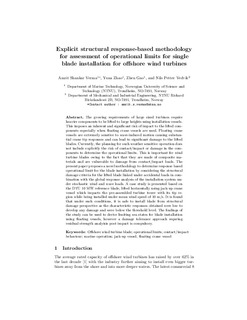| dc.contributor.author | Verma, Amrit Shankar | |
| dc.contributor.author | Zhao, Yuna | |
| dc.contributor.author | Gao, Zhen | |
| dc.contributor.author | Vedvik, Nils Petter | |
| dc.date.accessioned | 2019-04-16T07:11:38Z | |
| dc.date.available | 2019-04-16T07:11:38Z | |
| dc.date.created | 2019-01-22T12:22:56Z | |
| dc.date.issued | 2019 | |
| dc.identifier.citation | Proceedings of the Fourth International Conference in Ocean Engineering (ICOE2018). Lecture Notes in Civil Engineering, vol 23. | nb_NO |
| dc.identifier.isbn | 978-981-13-3134-3 | |
| dc.identifier.uri | http://hdl.handle.net/11250/2594722 | |
| dc.description.abstract | The growing requirements of large-sized offshore wind turbines require heavier components to be lifted to large heights using installation vessels. This imposes a substantial risk of impact to the lifted components especially when floating crane vessels are used. Floating crane vessels are in general sensitive to wave-induced motion, causing substantial crane tip responses and can lead to significant damage to the lifted blades. Currently, the planning for such weather sensitive operation does not include explicitly the risk of contact/impact or damage in the components to determine the operational limits. This is important for wind turbine blades owing to the fact that they are made of composite materials and are vulnerable to damage from contact/impact loads. The present paper proposes a novel methodology to determine response based operational limit for the blade installation by considering impact loads. Structural damage criteria for the lifted blade under accidental loads are linked with global response analysis of the installation system under stochastic wind and wave loads. A case study is also presented where a wind turbine blade lifted horizontally using jack-up crane vessel impacts the pre-assembled turbine tower with its tip region while being installed under mean wind speed of 10 m/s. It is found that under such conditions, it is safe to install blade from structural damage perspective as the characteristic responses obtained were low to develop any damage in the blade. The findings of the study can be used to derive limiting sea states for blade installation using floating vessels, however a damage tolerance approach requiring residual strength analysis post impact is compulsory. | nb_NO |
| dc.language.iso | eng | nb_NO |
| dc.publisher | Springer, Singapore | nb_NO |
| dc.relation.ispartof | Proceedings of the Fourth International Conference in Ocean Engineering (ICOE2018) Volume 2 | |
| dc.relation.ispartofseries | LNCE;volume 23 | |
| dc.subject | Offshore wind turbine blade, Operational limits, Contact/impact behaviour, Marine operation, Jack-up vessel, Floating crane vessel | nb_NO |
| dc.title | Explicit Structural Response-Based Methodology for Assessment of Operational Limits for Single Blade Installation for Offshore Wind Turbines | nb_NO |
| dc.type | Chapter | nb_NO |
| dc.description.version | acceptedVersion | nb_NO |
| dc.source.pagenumber | 737-750 | nb_NO |
| dc.identifier.doi | 10.1007/978-981-13-3134-3_55 | |
| dc.identifier.cristin | 1662904 | |
| dc.description.localcode | The final authenticated version is available online at https://doi.org/10.1007/978-981-13-3134-3_55 Embargo applies until December 31, 2019 | nb_NO |
| cristin.unitcode | 194,64,20,0 | |
| cristin.unitcode | 194,64,92,0 | |
| cristin.unitname | Institutt for marin teknikk | |
| cristin.unitname | Institutt for maskinteknikk og produksjon | |
| cristin.ispublished | true | |
| cristin.fulltext | original | |
| cristin.fulltext | postprint | |
| cristin.qualitycode | 1 | |
